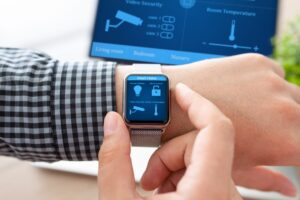Science fiction has long predicted a future of tiny wearable devices that do everything from monitor health and improve physical performance to stream video. That fiction is quickly becoming reality. New wearable devices—smart watches, bracelets, shoes, rings, glasses, and even clothing—are launched every day.
But there are technical challenges to making wearables even more mainstream. Here are a few, and some possible solutions.
The low-power struggle
Power is the bane of any small portable electronic device. Wearable tech can’t be tethered and won’t be practical if it needs to be recharged every six hours. Traditional batteries are heavy, expensive, and they need to be recharged on a regular basis. Thankfully we’re making progress in multiple dimensions. First, we are fine-tuning semiconductor devices to use less and less energy for a given task while optimizing them for wearable use cases.
At the same time, we are developing thin-film batteries, like ST’s EnFilm, that are well suited to wearables; and we can harvest energy from motion, light, and temperature differences. Small, high-efficiency solar panels and tiny piezoelectric devices that capture energy from movement and temperature exist today and can be embedded in clothing to provide power.
A small world
Wearable devices need to be small, there’s no way around it. Heavy, bulky gadgets simply won’t do. To make wearable gadgets lightweight and compact, we’ll need to integrate multiple functions into every component. That means processors combined with wireless chipsets, sensors, and more. We call it System in Package (SiP) and it results in smaller, slimmer and more efficient system solutions.

Connected to the Cloud
The Cloud is another key to wearable devices. They need to communicate with each other and send information to the ’Net. And with storage limited by space and cost constraints, storing information on remote servers is ideal for wearables. And with compact, low-power wireless chipsets able to stream information directly or via smartphones or other connected devices, relaying sensor readings and more to the Cloud is easy and effective.
Novel Interfaces
Wearable devices are, of course, tiny. The push for smaller products has encouraged development of new user interfaces. These need touchscreens, gesture-based UIs, voice control, and more technologies that we work on.
The wearable future
Social networks have driven the emergence of new wellness and fitness apps that connect people to their community of sports friends. User interfaces have changed the way we interact with electronics. Telemedicine devices like portable ECG monitors, smart contact lenses and even insulin dispensers for diabetics are already on the market. But they’re just the beginning.
Soon we’ll access and control networks of wearable devices with small gestures or even eye movements. One day medical monitoring devices will likely be implanted in the human body and doctors will do routine checkups or even monitor chronic illnesses remotely over the Internet. Wearable devices have tremendous potential and we’re extremely excited to be partnering with many leading innovators to work on them.
